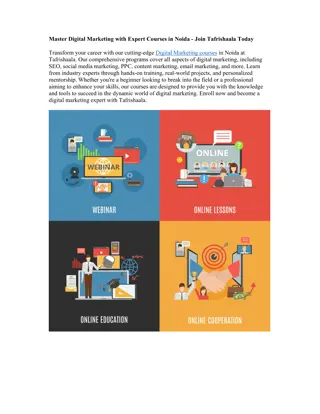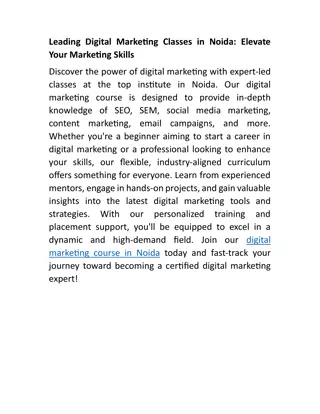Understanding Marketing: Key Concepts and Strategies
Marketing is the process of creating value for customers and building strong relationships to capture value in return. It involves attracting new customers with superior value and retaining existing ones by delivering satisfaction. The marketing process encompasses understanding customer needs, building profitable relationships, and designing customer-driven strategies. Different orientations in marketing focus on production, product quality, sales features, and ultimately satisfying customer needs. The concept of marketing goes beyond selling and is essential for the entire business to be customer-centric. The marketing mix and extended marketing mix play vital roles in developing strategies for businesses like Burger King.
Download Presentation

Please find below an Image/Link to download the presentation.
The content on the website is provided AS IS for your information and personal use only. It may not be sold, licensed, or shared on other websites without obtaining consent from the author. Download presentation by click this link. If you encounter any issues during the download, it is possible that the publisher has removed the file from their server.
E N D
Presentation Transcript
Definition The process by which companies create value for customers and build strong customer relationships in order to capture value from customers in return. Kotler and Armstrong (2010). Marketing is the management process for identifying, anticipating and satisfying customer requirements profitably. The Chartered Institute of Marketing (CIM).
The twofold goal Attract new customers by promising superior value Keep and grow current customers by delivering satisfaction All ways low prices
The Marketing Process Capture values from customers in return Create value for customers and build customer relationship Understand the market place & customer needs and wants Build profitable relationships and create customer delight Construct an integrated marketing programme that delivers superior value Capture value from customers to create profits and customer quality Design a customer- driven marketing strategy
Marketing Concept Marketing is not only much broader than selling, it is not a specialized activity at all. It encompasses the entire business. It is the whole business seen from the point of view of the final result, that is, from the customer's point of view. Concern and responsibility for marketing must therefore permeate all areas of the enterprise. Drucker (1955, 2007).
Production orientation- focus was on the science of manufacturing Product orientation- focus on the quality and desirability of a certain product Sales orientation- products sold based upon features rather than the benefits to the individual customer and his or her needs Market orientation- needs and wants are satisfied through the delivery of value to satisfied customers
Marketing Mix for Burger King Product As a fast food hamburger restaurant chain, BK produces, hamburgers, cheeseburgers as well as Fries, Salads, Hash browns, Coffee, Juice, Shakes, cookies and pies. Offering a retail line of microwaveable Burger King Brand French fries at select retailers in the United States Starbucks Corp.'s Seattle's Best Coffee to all its U.S. restaurants
Price The Price that is charges for the products on offer $1 double cheese burger Slushy drinks for $1 The Premium Burger at a higher price Place Burger King operates its business via franchises, under a franchise arrangement, the franchisees invest in the equipment, signage, and decor, while the company owns/leases the land and building
Promotion Driving sales through Facebook The BK Crown Card BK eGift card ATL campaigns YouTube Videos Get a tasty new look Facebook Campaign Gift Card
The Digital Age The rise of the Internet New communication and advertising tools (Cellphones, ipods, interactive TV, etc..) Bricks-and-mortar to click-and mortar The pace/speed of innovation Better segmentation More focused communications
Rapid Globalization Global competition International supply chain Irrelevance of country of origin concept E.g: Coke offers more than 400 Brands in 200 countries Product range
Ethics & Social responsibility Marketers to take greater responsibility for social & environmental impact Increase in consumer out cries and legal issues Companies may react to this in different ways Some take a pro-active approach E.g: Patagonia- Pledging 1% of sales or 10% of profits, which ever is higher, to the protection of the natural environment
Growth of Not-for-profit marketing This includes colleges, hospitals, museums, zoos, etc Colleges compete for students and funds NFP s- YMCA, The Salvation Army, etc.. Compete for membership Government agencies- branches of the US military, US postal service
Start by identifying the product or service that you want to analyze. Now go through and answer the 4Ps questions as defined in detail above
Product/Service What does the customer want from the product/service? What needs does it satisfy? What features does it have to meet these needs? Are there any features you've missed out? Are you including costly features that the customer won't actually use? How and where will the customer use it? What does it look like? How will customers experience it? What size(s), color(s), and so on, should it be? What is it to be called? How is it branded? How is it differentiated versus your competitors? What is the most it can cost to provide, and still be sold sufficiently profitably? (See also Price, below).
Place Where do buyers look for your product or service? If they look in a store, what kind? A specialist boutique or in a supermarket, or both? Or online? Or direct, via a catalogue? How can you access the right distribution channels? Do you need to use a sales force? Or attend trade fairs? Or make online submissions? Or send samples to catalogue companies? What do you competitors do, and how can you learn from that and/or differentiate? Price What is the value of the product or service to the buyer? Are there established price points for products or services in this area? Is the customer price sensitive? Will a small decrease in price gain you extra market share? Or will a small increase be indiscernible, and so gain you extra profit margin? What discounts should be offered to trade customers, or to other specific segments of your market? How will your price compare with your competitor
Promotion Where and when can you get across your marketing messages to your target market? Will you reach your audience by advertising in the press, or on TV, or radio, or on billboards? By using direct marketing mailshot? Through PR? On the Internet? When is the best time to promote? Is there seasonality in the market? Are there any wider environmental issues that suggest or dictate the timing of your market launch, or the timing of subsequent promotions? How do your competitors do their promotions? And how does that influence your choice of promotional activity?























